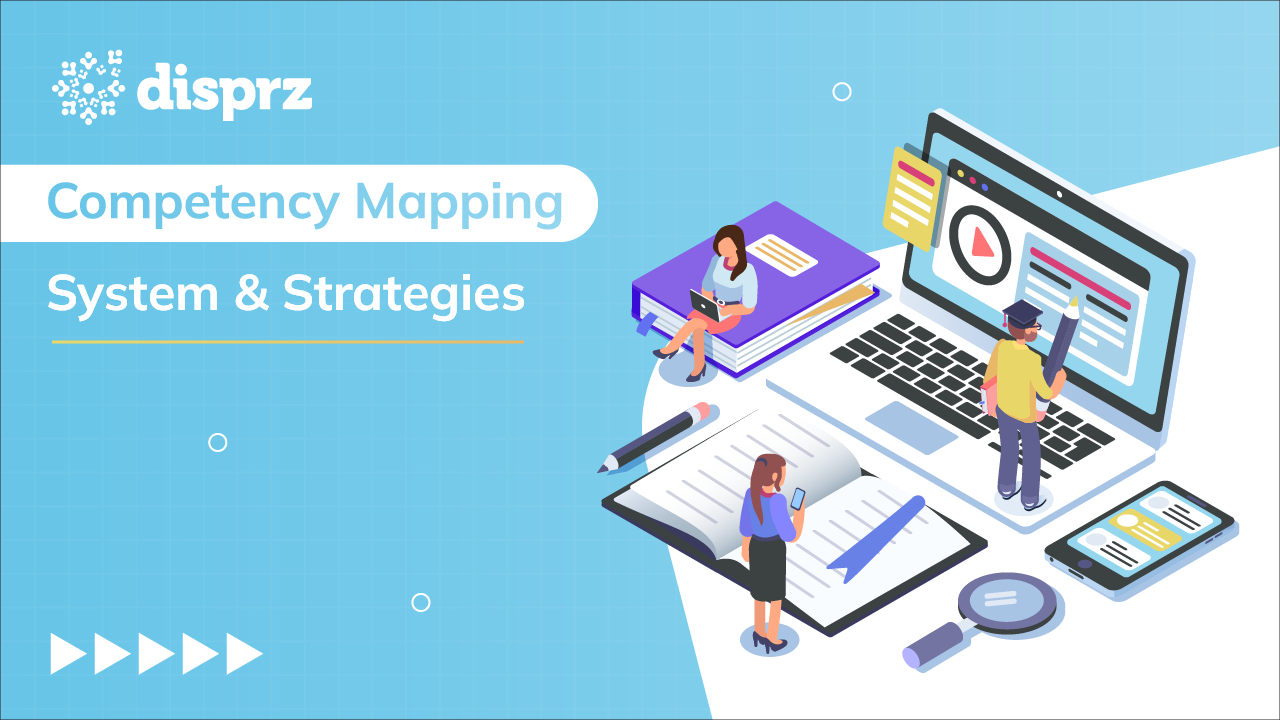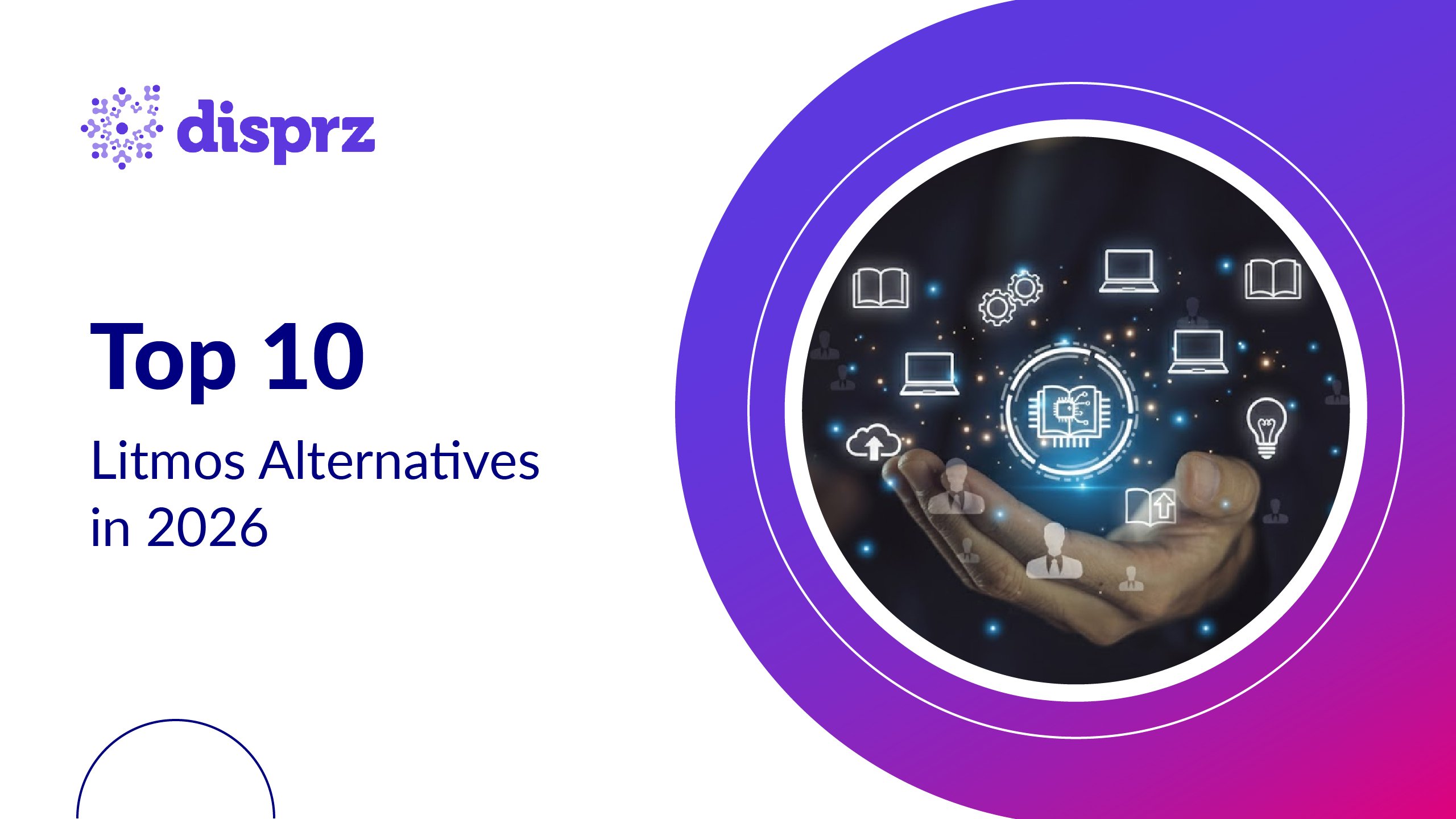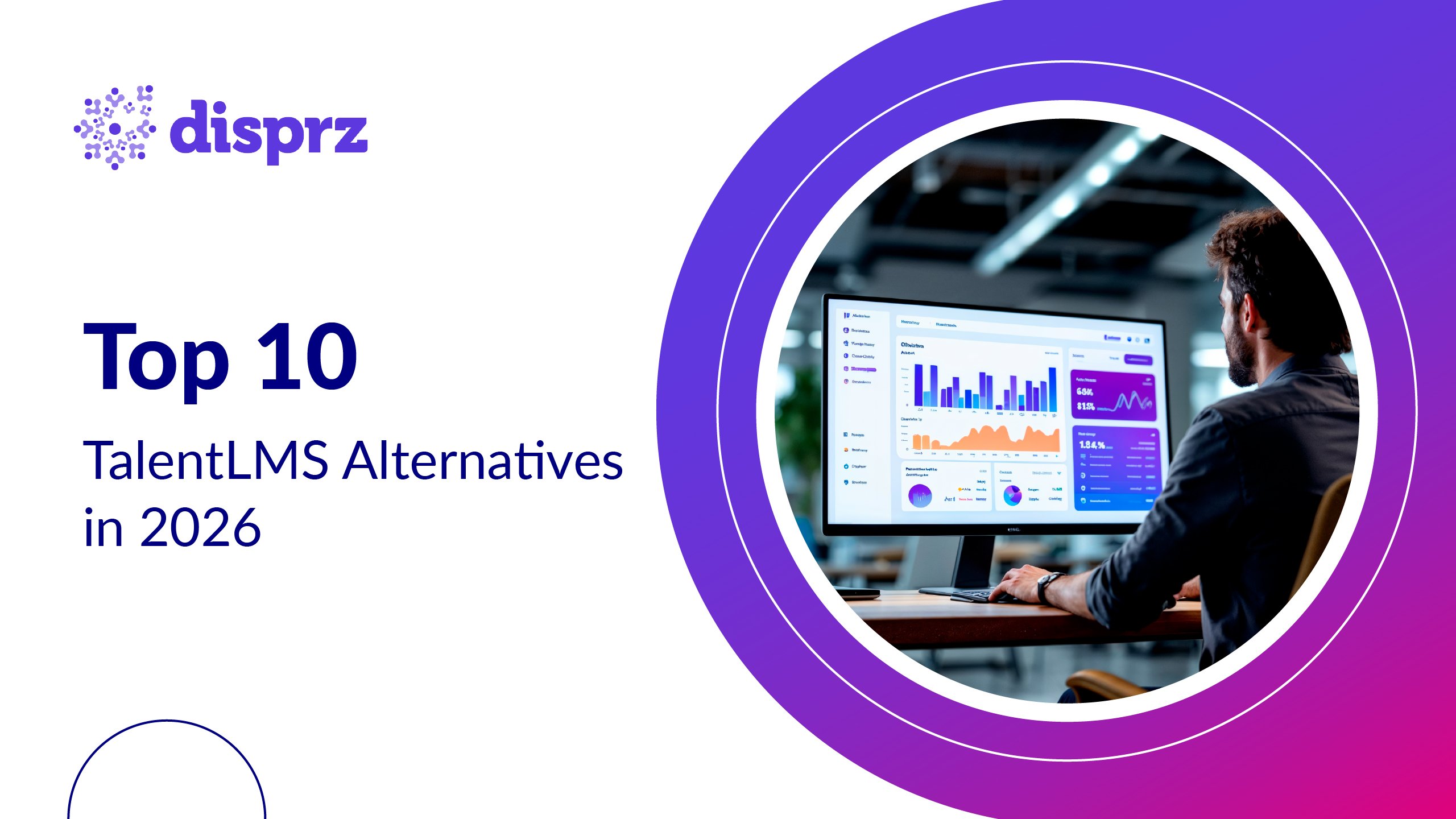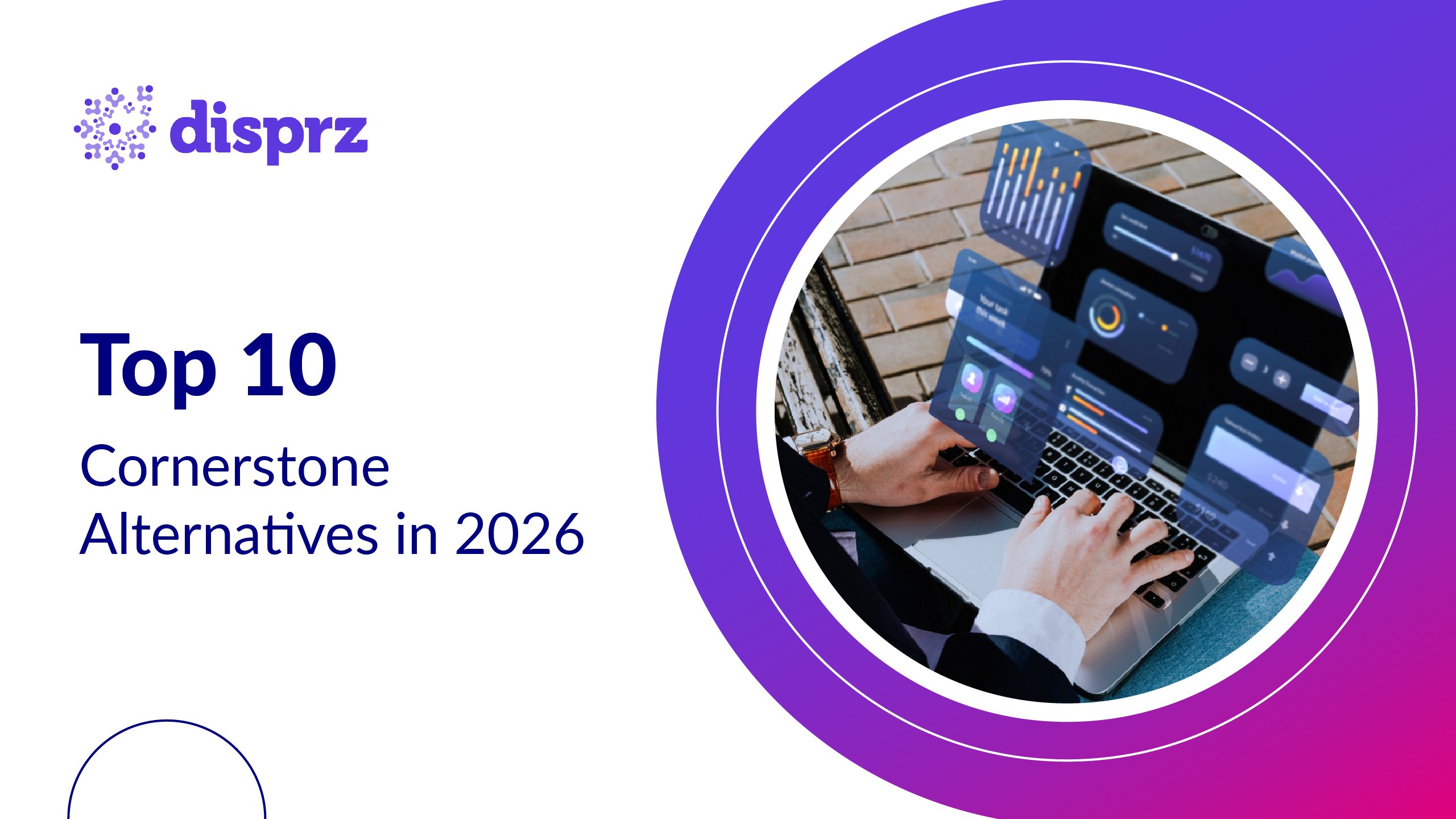In 2025, competency mapping has evolved from a support tool into the strategic backbone of workforce transformation. AI-powered skill intelligence platforms now infer competencies from performance data, learning histories, and dynamic ontologies; surfacing gaps, personalizing development, and aligning talent with shifting business priorities.
Learning pathways, structured and competency-aligned, guide employees through adaptive upskilling and reskilling journeys. By combining AI-driven insights with defined pathways, organizations ensure development that is purposeful, scalable, and career-aligned.
Competency mapping today is a real-time, intelligent system that connects workforce potential with business agility — helping enterprises stay future-ready, innovative, and competitive in an AI-enhanced market. Modern platforms such as Disprz LMS bring this to life by using AI-driven competency mapping to surface skill gaps and guide upskilling pathways, ensuring workforce agility.
What is Competency Mapping? A 2025 Perspective
Competency mapping identifies the specific skills, behaviors, and knowledge required for employees to perform effectively in their roles. Unlike traditional skill assessments, competency mapping emphasizes holistic performance by integrating technical, behavioral, and leadership competencies.
Today, competency mapping has transcended its conventional role, leveraging data analytics, artificial intelligence (AI), and real-time feedback. It now serves as a dynamic tool to anticipate future skill needs, enabling organizations to remain agile in a rapidly changing business environment. Modern competency mapping tools offer unparalleled insights, allowing L&D and HR leaders to create targeted learning paths and bridge critical skill gaps.
How AI & Analytics Are Shaping Competency Mapping in 2025
AI and advanced analytics are transforming competency mapping from a static framework into a living, data-driven system. Instead of relying only on manager assessments or generic role definitions, organizations now leverage AI in competency mapping to analyze performance data, learning patterns, and market trends in real time. Predictive analytics highlight emerging skill gaps, while machine learning models recommend personalized learning pathways to bridge them.
By embedding these insights into a well-defined HR competency framework, leaders can ensure consistency and scalability across roles and functions. This shift enables HR and L&D leaders to continuously align workforce competencies with evolving business priorities. In 2025, competency mapping is not just descriptive; it’s predictive, adaptive, and actionable, ensuring employees stay future-ready in an AI-driven economy.
Why Competency Mapping is Critical for Talent Management
The talent landscape of 2025 demands agility, innovation, and resilience. Competency mapping ensures that organizations have the right people with the right skills in the right roles.
Here are the key reasons why it’s indispensable for talent management:
Aligning Skills with Business Goals
Competency mapping enables organizations to identify and cultivate skills that directly contribute to achieving strategic objectives.
Enhancing Employee Engagement
Employees feel more valued, engaged, and motivated when their growth aligns with clearly defined competencies and career pathways.
Improving Talent Retention
By providing personalized development opportunities, competency management reduces turnover rates.
Future-Proofing the Workforce
Organizations can proactively prepare for industry disruptions by identifying emerging skill requirements.
Linking Competencies to Career Pathways & Upskilling
Competency mapping in 2025 goes beyond identifying gaps; it’s about creating clear career pathways that motivate employees and future-proof organizations. By linking competencies directly to role progression, companies can show employees how today’s skills unlock tomorrow’s opportunities.
When combined with AI-driven insights, this mapping enables personalized upskilling journeys, ensuring each learner follows a structured path aligned with both business goals and personal aspirations. For HR and L&D leaders, this translates into higher engagement, stronger retention, and a workforce equipped with future-ready skills. In essence, competency mapping becomes the engine that powers career growth, internal mobility, and scalable reskilling initiatives across the enterprise.
Key Benefits of Competency Mapping for Organizations
Competency mapping delivers measurable business impact by aligning people capabilities with organizational goals. In 2025, its benefits extend well beyond skill tracking:
-
Smarter Workforce & Succession Planning: Build a pipeline of future-ready leaders by anticipating capability needs and grooming talent for critical roles.
-
Efficient Recruitment & Role Alignment: Hire faster and better by mapping job descriptions to precise competencies, ensuring new hires are role-ready from day one.
-
Personalized Upskilling & Career Pathways: Guide employees with structured learning journeys linked to current roles and future opportunities, boosting engagement and retention.
-
Enhanced Performance & Productivity: Equip employees with the right skills at the right time, directly impacting business outcomes.
-
Regulatory Compliance & Risk Management: Track certifications and compliance-linked skills to minimize operational risks and avoid penalties.
By aligning competencies with learning investments, organizations also see an improved ROI of L&D programs, making competency mapping a strategic driver of both performance and cost efficiency.
Real-World Examples of Competency Mapping in Action
Case 1: Retail Giant’s Leadership Development Program
A global retail organization implemented competency mapping to enhance its leadership pipeline. Using competency mapping software, they identified gaps in strategic thinking and decision-making skills. Tailored training programs addressed these gaps, resulting in a 30% improvement in leadership effectiveness.
Case 2: Tech Firm’s Agile Transformation
A global technology firm leveraged competency mapping tools to transition into agile methodologies. By mapping competencies such as collaboration, adaptability, and technical expertise, they successfully upskilled 80% of their workforce, accelerating project delivery timelines by 25%.
Case 3: Major Banking Player’s Workforce Skills Alignment
A leading UAE-based bank used competency mapping to align workforce skills with its Emiratization goals, ensuring local talent was equipped with the right technical, digital, and leadership capabilities. By linking competencies to structured upskilling pathways, the bank not only met regulatory requirements but also accelerated the development of high-potential Emirati employees. This approach strengthened succession pipelines, improved workforce agility, and demonstrated how competency mapping can support both national priorities and organizational growth.
The Competency Mapping Process: A Step-by-Step Approach
Implementing competency mapping requires a structured approach that is both systematic and adaptable to organizational needs. This ensures that the process not only identifies current skill levels but also aligns them with future business objectives.
Here’s a step-by-step guide to help HR leaders and L&D professionals effectively execute competency mapping:

Step 1: Define Business Goals
Anchor competency mapping to strategic priorities such as business growth, digital transformation, compliance, or innovation.
Step 2: Identify Critical Roles
Pinpoint roles driving the highest business impact and future readiness.
Step 3: Build Competency Frameworks
Outline technical, behavioral, and leadership competencies needed per role.
Step 4: Assess Current Skills
Collect data from performance reviews, assessments, and feedback to benchmark.
Step 5: Spot Skill Gaps
Compare current capabilities with required competencies to highlight gaps.
Step 6: Design Learning Pathways
Create structured, progressive journeys that align skills to roles and careers.
Step 7: Implement & Monitor
Roll out learning interventions, track adoption, and refine as needed.
Step 8: Integrate AI & Continuous Analytics
Use AI-powered platforms to infer competencies, deliver adaptive learning, and provide real-time insights for ongoing alignment.
By following this structured approach, organizations can ensure a smooth and impactful implementation of competency mapping, resulting in a workforce that is both skilled and strategically aligned.
Essential Tools & Systems for Competency Mapping
In 2025, competency mapping relies on a connected ecosystem of tools. From AI platforms to assessments, each enables sharper gap detection, smarter pathways, and future-ready talent.
-
AI-Powered Competency Platforms: Leverage AI to infer skills from data, surface gaps, and recommend personalized, adaptive development pathways.
-
Competency Management Systems (CMS): Centralize and update competency frameworks, map roles, and integrate seamlessly with HR and talent systems.
-
LMS & Learning Experience Platforms: Align learning content with competencies, track progress, and deliver structured pathways across self-paced and blended models.
-
Feedback & Assessment Tools: Provide 360 degree feedback, self-assessments, and tests to validate skills and generate real-time performance insights.
Competency-Based Talent Management: Strategies for Leaders
To fully leverage competency mapping, HR leaders should adopt the following strategies:
Integrate Competency Frameworks Across HR Functions
From recruitment to performance reviews, embed competencies in all HR processes.
Foster a Learning Culture
Encourage continuous upskilling by linking competencies with career advancement.
Collaborate with Business Leaders
Ensure alignment between competency mapping initiatives and business priorities.
Leverage Technology
Invest in cutting-edge competency mapping tools and systems to stay ahead.
Adopt Agile Methodologies
Regularly update competency frameworks to reflect evolving industry trends.
Use Skill Intelligence & Analytics to Drive Decisions
Apply AI-driven skill intelligence and analytics to identify trends, predict future needs, and make data-backed talent decisions.
Embed Competency Mapping into Upskilling Pathways
Design upskilling and reskilling programs that are competency-aligned, ensuring employees build future-ready skills in a structured, measurable way.
How to Choose the Right Competency Mapping Software
When evaluating platforms, leaders should focus on features that balance usability, intelligence, and integration.
Key considerations include:
-
Ease of Use: Simple, intuitive interface for employees, managers, and administrators.
-
Customization: Ability to adapt frameworks to industry, role, and organizational needs.
-
Look for AI-Driven & Skills Taxonomy Features: Ensure future-readiness with AI-based inference and dynamic skill libraries.
-
Integration: Seamlessly integrates with learning platforms (LMS and LXP) to enable competency-aligned pathways.
-
Analytics & Reporting: Real-time dashboards to track adoption, gaps, and progress.
-
Scalability & Security: Handle enterprise-wide needs with strong compliance and data protection.
Future Trends in Competency Mapping
As organizations prepare for 2025 and beyond, competency mapping is rapidly evolving from static frameworks to intelligent, predictive systems. These trends highlight how technology and strategy will reshape how companies identify, develop, and deploy talent.
Rise of AI & Generative AI in Competency Mapping
AI and GenerativeAI are transforming skill intelligence; inferring competencies from data, automating frameworks, and even generating personalized development recommendations at scale.
Competency and Career Pathways Integration
Competency mapping is increasingly embedded into career journeys, aligning skills with long-term progression and enabling employees to see clear growth pathways.
Predictive Skill Gap Analysis & Workforce Planning
Advanced analytics anticipate future skill shortages, enabling proactive workforce planning and reducing risks from talent gaps.
Increased Focus on Behavioural & Leadership Competencies
Beyond technical skills, organizations are emphasizing behavioral and leadership competencies to build resilient, adaptive, and people-centric workforces.
Conclusion
Competency mapping in 2025 is no longer a static HR exercise; it is the foundation of workforce agility and business resilience. By combining AI-driven skill intelligence, structured pathways, and integrated systems, organizations can continuously align talent with evolving priorities and future demands.
Leaders who embrace this shift will not only close today’s skill gaps but also anticipate tomorrow’s. Competency mapping becomes the bridge between strategy and execution; ensuring the right people, with the right skills, are always in place to drive growth. It empowers enterprises to build adaptive, innovative, and future-ready teams at scale.
See how the Disprz Competency Management System helps enterprises future-proof their workforce.
FAQs
1) What are the main steps in competency mapping?
The core steps include: defining organizational goals; identifying core technical, behavioral, and leadership competencies aligned to those goals; developing a competency framework (levels, role-specific vs organization-wide); evaluating current competency levels via assessments, self / manager evaluations; identifying gaps and prioritizing critical ones; implementing development plans (training, mentoring, etc.); and then continuously monitoring & refining the framework.
2) How does AI improve competency mapping in 2025?
AI helps by analysing large pools of data (performance metrics, assessments, feedback) to predict future competency needs, spotting emerging gaps earlier, and enabling personalized learning paths. It also enhances automation in assessments, adapts frameworks dynamically, and makes insights more actionable in real time.
3) What is the difference between skills mapping and competency mapping?
Skills mapping typically focuses on specific abilities or technical proficiencies an employee has (e.g. software skills, tools, techniques), whereas competency mapping is broader; it includes not only skills but also behaviors, knowledge, personality traits, and leadership capabilities. Competency mapping thus gives a more holistic view of what makes someone effective in a role.
4) How do competency frameworks help in talent management?
Competency frameworks provide structure and clarity; they help in aligning hiring, assessment, performance reviews, learning & development and career planning to wider business goals. They make it possible to measure performance more objectively, identify development needs, plan succession, retain talent by showing clear progression paths.
5) What software is best for competency mapping?
The best software will depend on your needs, but high value comes from platforms that offer role-based competency frameworks, robust assessment tools, strong analytics and reporting, easy integration with HR/LMS/LXP systems, and scalability. Look for AI-powered competency management systems that support customization, user-friendly interfaces, and real-time feedback features.









